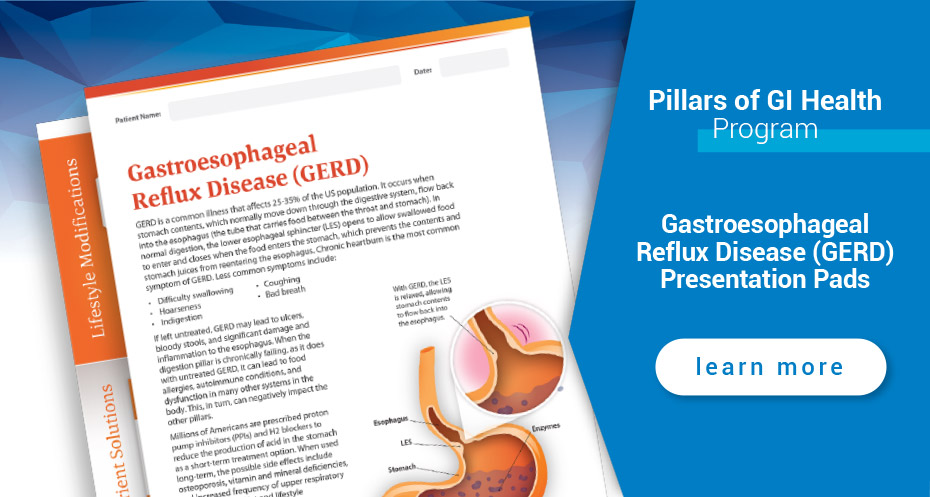Take a moment to reflect how many of your patients experience heartburn or prolonged coughing. More than likely, it may be too many to count. And chances are if these patients are experiencing symptoms more than a couple times a week after eating, it may be gastroesophageal reflux disease (GERD), a very common condition affecting one in five Americans, and the trend is growing rapidly.1
What is GERD?
In normal digestive function, the lower esophageal sphincter (LES) opens to allow swallowed food to enter and closes when the food enters the stomach, which prevents the contents from flowing back into the esophagus. The LES is controlled by an integrated balance of neurotransmitters and hormones, as well as acid stimulation, which helps the LES close tightly.2,3 However, with age, the LES generally loosens, stomach acid gradually decreases, and GERD becomes more prevalent.4
With GERD, the LES is chronically loose, allowing even a small amount of acid in the stomach to flow back into the esophagus, irritating the lining. At a closer look, we know that the foveolar cells in the lining of the stomach secrete mucous that protects it from its acidic contents, but the esophagus does not contain such mucus-secreting cells to protect it, adding to the irritation. If left untreated, the compounded irritation from GERD may lead to inflammation, ulceration and significant damage to the esophagus. Over time, damage to the tissue from untreated GERD leads to conditions like Barrett’s esophagus and downstream digestive deficiency consequences like food sensitivities and autoimmune conditions—a dismal outlook for these patients.4
Traditional Medicine Treatment Options
We are all familiar with the medications commonly prescribed for GERD. Millions of Americans are prescribed proton pump inhibitors (PPIs) to reduce the production of acid in the stomach as a short-term treatment option. However, when they are used long-term (and they often are), the possible side effects are severe, and may include osteoporosis from vitamin and mineral deficiencies, increased frequency of upper respiratory tract infections, or microbial imbalances in the GI tract (e.g., Clostridium difficile infections in hospital settings, small intestinal bacterial overgrowth, etc.).5
Functional Medicine Treatment Options
With a functional medicine approach, you can provide patients relief with strategies containing healthy lifestyle habits and targeted nutritional supplementation, focused on either strengthening the LES, correcting acid imbalances, or healing and rebuilding irritated mucosal membrane tissue. Incorporation of these strategies may depend on patient history, symptom severity, or duration of complaints.
To help soothe and rebuild irritated mucosal membrane tissue, consider the following:
- Deglycyrrhizinated licorice (DGL), marshmallow root, aloe vera extract and slippery elm bark are traditional herbs rich in mucilage and help provide a protective barrier over mucus membranes. They help soothe irritation, maintain inflammatory balance, and coat the lining of the gastric area.
- Mastic gum has been historically used to support the health of the stomach, protect the digestive system against duodenal and peptic ulcers, fight off H. pylori and soothe dyspeptic complaints.
- Bismuth is a naturally occurring mineral, frequently used to soothe the gastric and mucosal linings, as well as promote microbial balance in the GI tract.
- Zinc carnosine helps stimulate mucus production and maintain the integrity of the gastric mucosal barrier, as well as defend against ulcerations.
- Berberine protects mucous membranes throughout the GI tract, as well as maintains healthy microbial balance.
- L-glutamine enhances the repair and regeneration of the cells of the mucosal lining.
To help correct acid imbalances, consider the following:
- Buffered vitamin C can neutralize stomach acid and help relieve symptoms and decrease frequency of heartburn.
- Digestive enzymes, including pepsin and plant-based enzyme blends, may enhance the emptying of the stomach contents and reduce symptoms.
- Ginger and artichoke work synergistically as a prokinetic agent to promote gastric emptying.
To help strengthen the LES, consider the following:
- Betaine HCL can be used to help bring the stomach to a more acidic pH to help the LES close tightly.
- Melatonin may impact stomach acid secretion and help the LES work more effectively, as well as ensure adequate sleep for those experiencing discomfort at night.
Targeted supplementation should be combined with lifestyle considerations and stress management. Studies show that psychosocial stress is a predictable and modifiable cause of GERD.6 Working with your patients to reduce overall stress with exercise, meditation and mindfulness may help them cope with this condition and improve their outcomes. Other lifestyle factors to consider include:
- Avoiding “acid-triggering” foods (such as alcohol)
- Eating smaller meals
- Avoiding sleeping on a full stomach, and elevating the head while sleeping
- Losing weight and exercising frequently (but not after eating)
The Bottom Line
As a clinician, you want helpful tools in your toolbelt to combat this common condition. Looking to targeted nutritional supplementation, along with lifestyle modifications, can help decrease frequency or improve GERD without the significant side effects of drug therapies. Theses strategies can help address underlying causes more effectively and offer a new perspective for your GERD patients, so that together, you can find more choices in the care pathway toward feeling better.

JOSEPH ORNELAS, PhD, DC

Dr. Joseph Ornelas is the Pillars of GI Health Brand Manager at Lifestyle Matrix Resource Center. He holds a PhD from University of Illinois with concentration in Health Economics, an MA degree in Public Policy from the Harris School at the University of Chicago, an MS degree in Health Systems Management from Rush University, and a DC degree from National University of Health Sciences. As a licensed provider and health economist, Dr. Ornelas has published numerous evidence-based clinical practice guidelines, helping to improve quality standards of care and provide value for health care practitioners across several specialty areas.
References
- Antunes C, Aleem A, Curtis SA. Gastroesophageal Reflux Disease. [Updated 2021 Jul 18]. In: StatPearls [Internet]. Treasure Island (FL): StatPearls Publishing; 2021 Jan-. Available from: https://www.ncbi.nlm.nih.gov/books/NBK441938/
- Rosen RD, Winters R. Physiology, Lower Esophageal Sphincter. [Updated 2021 Apr 20]. In: StatPearls [Internet]. Treasure Island (FL): StatPearls Publishing; 2021 Jan-. Available from: https://www.ncbi.nlm.nih.gov/books/NBK557452/
- Prousky J. Principles and Practices of Naturopathic Clinical Nutrition. CCNM Press Inc 2008
- Thrift AP, Kramer JR, Qureshi Z, Richardson PA, El-Serag HB. Age at onset of GERD symptoms predicts risk of Barrett's esophagus. Am J Gastroenterol. 2013;108(6):915-922. doi:10.1038/ajg.2013.72
- Landers SJ. Long-term use of acid reflux drugs weighed. Am Med News. September 1, 2008:27.
- Haruma K, Kinoshita Y, Sakamoto S, Sanada K, Hiroi S, Miwa H. Lifestyle factors and efficacy of lifestyle interventions in gastroesophageal reflux disease patients with functional dyspepsia: primary care perspectives from the LEGEND study. Intern Med. 2015;54(7):695-701.




